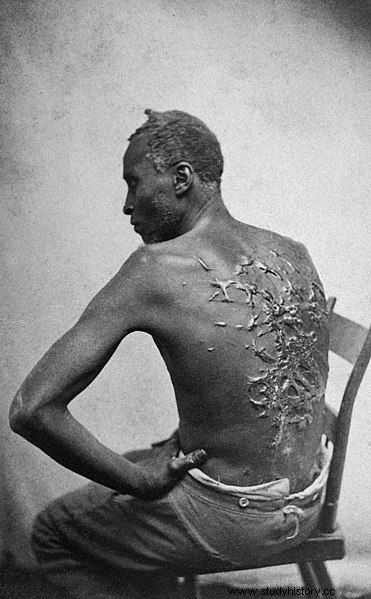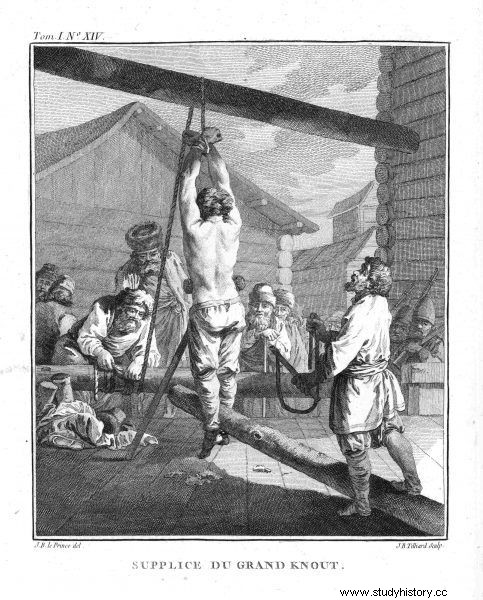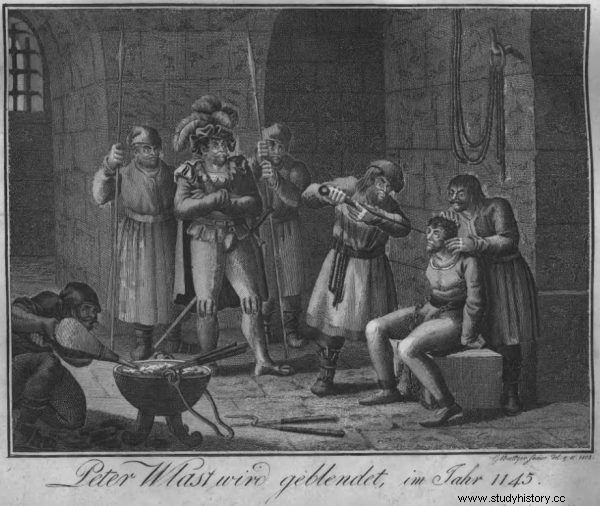For thousands of years, mankind has developed, refined and applied forms of punishment and physical violence. Flogging was the most popular and long-lasting way of inflicting suffering, but it is the loss of testicles or gouging out the eyes that chills the blood in the veins the most.
The situation of a slave was never to be envied. Slaves were most often punished painfully. This state of affairs did not change until the abolition of slavery in the second half of the 19th century. Already dating from the 18th century B.C.E. The "Hammurabi Code" made it clear that the principle of "an eye for an eye, and a tooth for a tooth" only applied to free citizens.
Article 199 cleared all doubts in case the slave was someone else's property:
If the eye of a citizen's slave is broken or a bone of a citizen's slave is broken, he will pay half the price.
In a situation where the torturer was also the owner of the slave, he could do with the subject as he pleased.
Punishment of flogging for slaves
Even in ancient Rome, flogging was the preferred form of punishing slaves. It was performed with several types of tools depending on the degree of the offense. The most delicate flogging was done with a flat leather belt (ferula). For more serious offenses, a whip made of stiff parchment strips (scutica) was used, and the slave was punished with a flagellum flogging made of leather thongs loaded with objects to inflict more pain and wounds, such as hooks or metal balls .

The slave who fell victim to the scourging
Flogging was a popular method of inflicting pain until the end of slavery. Even in the nineteenth-century New Orleans, torturers were able to torture a black slave in the light of the law using a whip:
At her side stood a huge black man with a long whip, which he operated with terrible force and wonderful precision. Each blow broke off a piece of skin that either stuck to the whip or shuddered to the pavement. Blood followed right behind her. Her body turned a bluish and bloody mass of raw and quivering muscles ...
Flogging criminals
By law, not only slaves were flogged. Flagellation was a form of the administration of justice for committed crimes many centuries BC.
According to the "Code of Hammurabi", such a sanction was punishable by false accusations against a priest, and 168 offenses under the Old Testament criminal law were for which flogging was due. Among them was sexual intercourse with a woman who was menstruating or incest. The instrument of the administration of justice was made of three or four folded straps.

Penalty of flogging, drawing by Jean-Baptiste Le Prince
In the Middle Ages, the whipping, to the delight of onlookers, was performed in public. The pillory to which the convicts were tied was placed in the central point of a given town, and the punished person not only suffered physical but also mental torture, bearing the contemptuous glances of the audience participating in this event. The instruments with which the punishment was carried out were, among others sticks, oak rods, whips or ropes.
In Europe, the flagellation of criminals in the name of the law continued until the 19th century. According to the "Code punishing the Kingdom of Poland" from 1818, it was possible to punish the villain from 16 to 120 strokes with a rod, but a maximum of 30 strikes at once. The "Code of Major and Corrective Penalties", dating from 1847, provided for flogging between 80 and 200 times, with a limit of 40 strokes at a time.
Mutilation punishments - cutting testicles, breasts or ear
Over the centuries, legal codes have provided, in addition to flagellation, other forms of the administration of justice for committed crimes. One of them was mutilation punishments, derived from the Latin word mutilatio, meaning mutilation, damage. Mutilation punishments were intended not only to inflict pain on the offender, but also to permanently damage the body of the convict. The type of punishment depended on the type of offense.
Mutilation penalties were in force already in the times of the "Hammurabi Code", as well as in Islamic or Jewish law, up to the nineteenth-century legal regulations in Europe. Initially, they operated on the basis of the talion principle (Latin:talio, meaning retaliation, retribution), that is, according to the "Code of Hammurabi":an eye for an eye, a tooth for a tooth. There was a death penalty for murder and an identical mutilation for bodily injury.
In the case of crimes not related to loss of life or health impairment, a decision was made to discourage and at the same time prevent a similar crime in the future. The hand would be cut off for the thieves, and two fingers for those who were swearing. Rape and adultery involved castration, blasphemy with cutting off the tongue, and card deception with gouging out the eyes.
A stigma for life
The most important goal of the stigma was to warn people about the criminal around them. The mark was most often burned on the face, sometimes on other parts of the body, using a hot iron tool molded into a sign of a specific offense symbol.

The blindness of Piotr Włostowic in 1145
As for the symbols themselves, the most popular ones were those derived from the first letters of the committed crimes. In ancient Rome, the letter F denoted runaway slaves (from Latin fugitivus - fugitive), in medieval England, the letter M (from manslaughter) for murderers, and the letter T (from thief) for thieves. In France, a stigma was burned until 1832, for example, to thieves in the form of the letter V (from French voleur).
Women condemned for witchcraft in Hungary were burned with the shape of a cross on their breasts, and a sign of a church key between the shoulder blades. In Gdańsk, criminals were marked with a stigma in the form of the city coat of arms. Other interesting symbols that were found on the foreheads of those who break the law include a dog's paw in a thief or genitals in an adulterer. In England, punishment in the form of stigma was abandoned in 1829, and in accordance with Polish law, in the "Code of main and corrective penalties" of 1847 there was a provision on the public execution of the stigma by the executioner and consisted of: [...] squeezing, in the manner prescribed , on the left shoulder blade of the convict three letters K.A.T. (initial words of backbreaking). Seventy-year-olds and women cannot be stigmatized.
Looking from the perspective of human history, man has never lacked ideas on forms of punishing those who did not comply with generally agreed standards. The progressive secularization of society and the reduction of the Church's influence in state matters had a significant impact on the easing of the manner of administering justice for crimes.
Bibliography:
- A. Golus, Childhood shadowed by the rod. The History and Faces of Violence Against Children, Editio 2019
- I. Bieżuńska-Małowist, M. Małowist, Niewolnictwo, Czytelnik 1987
- L. Lyons, A History of Corporal Punishment, Bellona 2010
- J. Warylewski, Kara. Philosophical and Historical Foundations, Publishing House of the University of Gdańsk 2007
- Code of main and corrective penalties, Warsaw 1847
